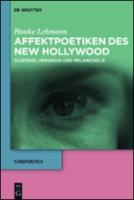Affektpoetiken des New Hollywood
Suspense, Paranoia und Melancholie
| dc.contributor.author | Lehmann, Hauke | |
| dc.date.accessioned | 2021-04-26T14:18:47Z | |
| dc.date.available | 2021-04-26T14:18:47Z | |
| dc.date.issued | 2016 | |
| dc.identifier | ONIX_20210426_9783110488739_24 | |
| dc.identifier.issn | 2509-4351 | |
| dc.identifier.uri | https://library.oapen.org/handle/20.500.12657/48419 | |
| dc.language | German | |
| dc.relation.ispartofseries | Cinepoetics | |
| dc.subject.classification | thema EDItEUR::A The Arts::AT Performing arts::ATF Films, cinema | en_US |
| dc.subject.classification | thema EDItEUR::A The Arts::AT Performing arts::ATJ Television | en_US |
| dc.subject.classification | thema EDItEUR::J Society and Social Sciences::JB Society and culture: general::JBC Cultural and media studies::JBCT Media studies | en_US |
| dc.subject.other | Film history/ in the USA | |
| dc.subject.other | affect | |
| dc.subject.other | temporality | |
| dc.title | Affektpoetiken des New Hollywood | |
| dc.title.alternative | Suspense, Paranoia und Melancholie | |
| dc.type | book | |
| oapen.abstract.otherlanguage | How do spectators become emotionally involved in cinema? Starting from this question, the book suggests an original view about a critical period in United States film history. In a detailed analysis of individual films, an image emerges of a complex interplay between three affective modes – suspense, paranoia, and melancholy – which draw the spectators to reflect in unique ways about contradictions in their own feelings. | |
| oapen.identifier.doi | 10.1515/9783110488739 | |
| oapen.relation.isPublishedBy | 2b386f62-fc18-4108-bcf1-ade3ed4cf2f3 | |
| oapen.relation.isbn | 9783110488739 | |
| oapen.relation.isbn | 9783110480115 | |
| oapen.relation.isbn | 9783110488760 | |
| oapen.series.number | 2 | |
| oapen.pages | 374 | |
| oapen.place.publication | Berlin/Boston |

